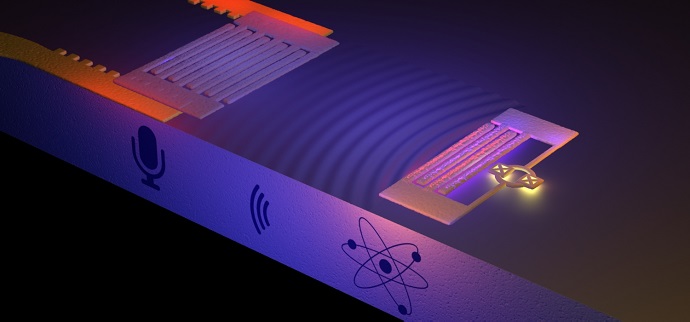Sep 12, 2014
Researchers at Chalmers University of Technology are first to show the use of sound to communicate with an artificial atom. They can thereby demonstrate phenomena from quantum physics with sound taking on the role of light. The results are published by the journal Science.
The interaction between atoms and light is well known and has been studied extensively in the field of quantum optics. However, to achieve the same kind of interaction with sound waves has been a more challenging undertaking. The Chalmers researchers have now succeeded in making acoustic waves couple to an artificial atom. The study was done in collaboration between experimental and theoretical physicists.
"We have opened a new door into the quantum world by talking and listening to atoms", says Per Delsing, head of the experimental research group. "Our long term goal is to harness quantum physics so that we can benefit from its laws, for example in extremely fast computers. We do this by making electrical circuits which obey quantum laws, that we can control and study."
An artificial atom is an example of such a quantum electrical circuit. Just like a regular atom, it can be charged up with energy which it subsequently emits in the form of a particle. This is usually a particle of light, but the atom in the Chalmers experiment is instead designed to both emit and absorb energy in the form of sound.
"According to the theory, the sound from the atom is divided into quantum particles", says Martin Gustafsson, the article's first author. "Such a particle is the weakest sound that can be detected."
Since sound moves much slower than light, the acoustic atom opens entire new possibilities for taking control over quantum phenomena.
"Due to the slow speed of sound, we will have time to control the quantum particles while they travel" says Martin Gustafsson. "This is difficult to achieve with light, which moves 100,000 times more quickly."

Microscope image of the artificial atom
The artificial atom, in grey-blue to the upper right, can emit and absorb sound that moves across the surface of a microchip. The grey-blue structure to the lower left is the combined loudspeaker/microphone used to communicate acoustically with the atom.
Credit: Martin Gustafsson and Maria Ekström
The low speed of sound also implies that it has a short wavelength compared to light. An atom that interacts with light waves is always much smaller than the wavelength. However, compared to the wavelength of sound, the atom can be much larger, which means that its properties can be better controlled. For example, one can design the atom to couple only to certain acoustic frequencies or make the interaction with the sound extremely strong.
The frequency used in the experiment is 4.8 gigahertz, close to the microwave frequencies common in modern wireless networks. In musical terms, this corresponds approximately to a D28, about 20 octaves above the highest note on a grand piano.

Microscope image, zoom-in of the artificial atom
Zoom-in of the artificial atom, with its integrated Superconducting Quantum Interference Device (SQUID) in violet. The SQUID gives the atom its quantum properties, and the fingers sticking up to the left provide the coupling to sound waves.
Credit: Martin Gustafsson and Maria Ekström
At such high frequencies, the wavelength of the sound becomes short enough that it can be guided along the surface of a microchip. On the same chip, the researchers have placed an artificial atom, which is 0.01 millimeters long and made of a superconducting material.
The paper Propagating phonons coupled to an artificial atom is published online by the journal Science, at the Science Express web site.















